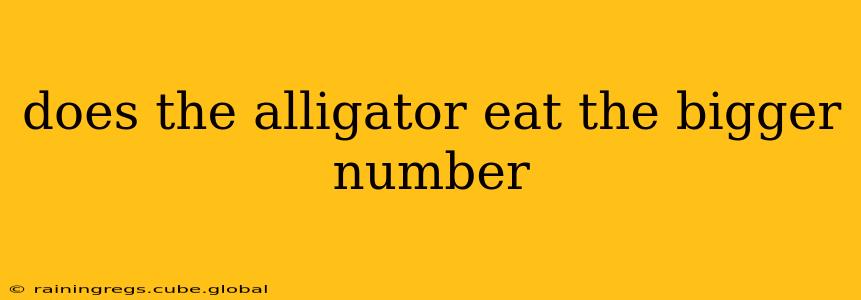Does the Alligator Eat the Bigger Number? A Fun Look at Math and Logic
This seemingly simple question, "Does the alligator eat the bigger number?", actually opens up a fascinating world of mathematical concepts and logical reasoning, especially for children learning about comparison. It's a playful way to introduce the important skill of comparing numbers.
The "alligator" in this context refers to the greater than/less than symbol (> or <). The alligator's mouth always opens towards the larger number, "eating" the bigger one. It's a memorable visual aid for young learners, making number comparison less abstract and more engaging.
What are Greater Than and Less Than Symbols?
The greater than symbol (>) and the less than symbol (<) are fundamental mathematical symbols used to compare two numbers. The open end of the symbol always points towards the larger number. Let's look at some examples:
- 5 > 2: Five is greater than two. The alligator's mouth is open towards the 5.
- 10 < 20: Ten is less than twenty. The alligator's mouth is open towards the 20.
Understanding these symbols is crucial for solving various mathematical problems, including ordering numbers, performing inequalities, and interpreting data.
How to Teach Children About the Alligator and Number Comparison?
Teaching children about the alligator method is simple and fun. You can use:
- Visual aids: Draw an alligator with an open mouth. Place two numbers on either side and ask your child which number the alligator should eat.
- Interactive games: Use flashcards or online games that involve comparing numbers using the alligator method.
- Real-world examples: Compare the number of toys, fruits, or other objects to reinforce the concept.
For instance, you can ask: "The alligator wants to eat the bigger number of apples. You have 3 apples, and your friend has 5 apples. Which number does the alligator eat?"
How Does the Alligator Method Help with Math Skills?
The alligator method is more than just a cute trick. It fosters essential mathematical skills, including:
- Number sense: Children develop a better understanding of number magnitude and relationships.
- Problem-solving: They learn to apply logical reasoning to solve comparison problems.
- Mathematical fluency: The visual representation aids in quick and accurate number comparisons.
What Other Ways Can Kids Learn to Compare Numbers?
While the alligator method is fantastic for visualization, there are other techniques you can use to reinforce number comparison:
- Number lines: Placing numbers on a number line helps children visually see which number is larger or smaller.
- Counting: Counting the objects represented by each number provides a concrete understanding of the quantity.
- Using blocks or counters: Manipulating physical objects facilitates understanding of quantities and comparisons.
By using various methods and making learning fun, children can effectively grasp the concepts of greater than and less than, forming a strong foundation for future mathematical learning. The playful "alligator eats the bigger number" approach is a fantastic starting point!
